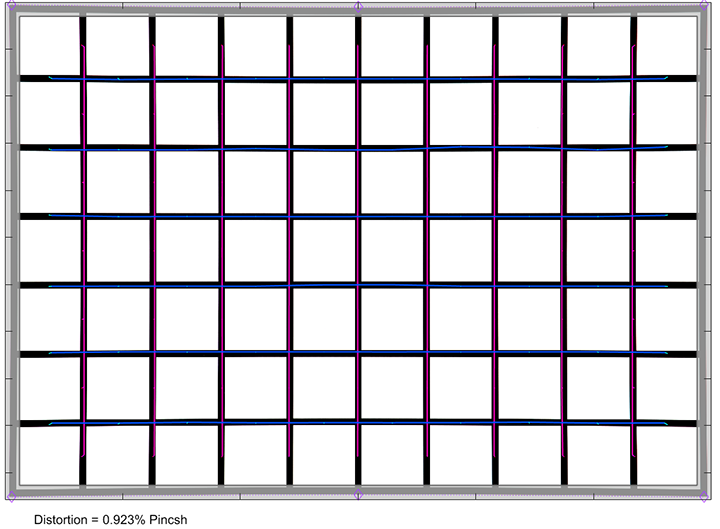Needless to say - it's a fully manual lens. Thus you set the aperture on the lens while (usually) setting the camera to aperture priority mode. Manual focusing is pure joy with this lens, and when using a magnified view, it's also precise. It does slow you down, but that's more part of the fun of using a vintage lens.
| Specifications |
|---|
| Optical construction | 5 elements in 4 groups |
| Number of aperture blades | 6 |
| min. focus distance | 1.20m (max. object magnification 1:9.1) |
| Dimensions | 57x63mm |
| Weight | 278g |
| Filter size | 49mm |
| Hood | optional, barrel-shaped |
| Other features | - |
| Mount | M42 |
Distortions
Back in the day, there was no image auto-correction, of course, thus designers had to optimize the real thing. The 105mm f/2.8 shows just a bit of pincushion distortion which usually goes unnoticed.

Vignetting
The vignetting is also very moderate with a light falloff of ~0.8EV (f-stops) at f/2.8. At f/4, the vignetting is negligible already.

MTF (resolution @ 42mp on Sony Full Format)
I reckon most of you are interested in how a 50-year-old lens performs on a high-megapixel full-format sensor (here: at 42mp). Well, the SMC Takumar 105mm f/2.8 struggles quite a bit. The center quality is actually pretty good at f/2.8 although the contrast level is much reduced. The outer image field is a different story though. Or in other words - it's extremely soft here. Stopping down to f/4 improves the center quality and especially the contrast level whereas the borders/corners are still unimpressive. This changes at f/5.6. The broader center is very good followed by good borders and just the extreme corners remain quite soft. They finally improve to good levels at f/8. f/8 is also the sweet spot of the lens. f/11 remains decent although diffraction takes its toll here.
The field curvature is low. The centering quality of the tested sample was good.
Below is a simplified summary of the formal findings. The chart shows line widths per picture height (LW/PH) which can be taken as a measure of sharpness.
If you want to know more about the MTF50 figures, you may check out the corresponding Imatest Explanations

Chromatic Aberrations (CAs)
Lateral CAs vary slightly with a typical average pixel width of 0.8px at the image borders. This is actually pretty good.

Bokeh
If you purchase a vintage lens you tend to do it either for budget reasons or because you are after a special character of a lens. The SMC Takumar 105mm f/2.8 has certainly some of the latter with respect to its bokeh.
Out-of-focus highlights show a very pronounced outlining at f/2.8 - or in other words: it bubbles. The inner zone of the discs is very smooth though. Stopping down to f/4 eliminates the outlining effect but you can clearly see the very edgy aperture shape, more so at f/8.

Despite the tiny front element, there doesn't seem to be too much mechanical vignetting. The highlight discs are broadly intact across the image field - we have seen a lot worse in modern lenses lately. Stopping down to f/4 results in an even more uniform highlight shape - albeit an edgy one as mentioned before.
The quality of the general blur in the focus transition zone is great in the background (shown to the left). The foreground blur is somewhat hazy though.

Bokeh Fringing / LoCA
Boheh fringing/LoCA is an axial color fringing effect with purplish halos in front of the focus point and greenish beyond.
Without revealing too much but this aspect is the one where most of the vintage lenses are struggling. As you can see below, the axial CAs are massive at f/2.8, especially in the foreground. It's not all that extreme anymore at f/4 and mostly gone from f/5.6 onward.
Sample Images
We'll post a couple of sample images at a later stage. This is a very time-consuming aspect and vintage tests are just 2nd class citizens for obvious reasons.
Verdict
The Asahi Pentax SMC Takumar 105mm f/2.8 isn't a hidden gem among vintage lenses. However, it still has its merits. In terms of resolution, you shouldn't expect too much - especially on a high-megapixel full-frame sensor. The center resolution is actually pretty decent at f/2.8 but the contrast level is low and the outer image field is plain soft. The overall quality is pretty good at f/8 but that's not a miracle really. Image distortions and lateral CAs are very low. This can't be said about axial CAs (LoCA) which are quite extreme. If you are looking for a special vintage character you may find it in the bokeh. The Takumar produces highlight bubbles at f/2.8 and the highlight discs are actually pretty nice across the image field. The out-of-focus background blur is also very smooth.
More so than the image quality, the primary joy of using this lens comes from its build quality. The metal body and buttery smooth control rings are simply superb. It's just something that you will appreciate immediately. Don't expect modern features such as weather sealing, of course. Needless to say, this is also a fully manual lens with all the pros and cons that come with it.
It's not surprising that these old Asahi Pentax SMC Takumars have many fans out there. They offer a true vintage feel - more so than some other oldies that we have tested. In terms of sheer optical performance, you should lower your expectations though - at least with respect to the Asahi Pentax SMC Takumar 105mm f/2.8. It may be Ok on a 24mp body but higher megapixel cameras are a bit too much for it really. If you are just into 4K video (=8.3 megapixels) you can relax, of course - you can almost mount a coke bottle and still get sharp results.